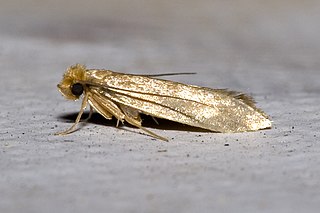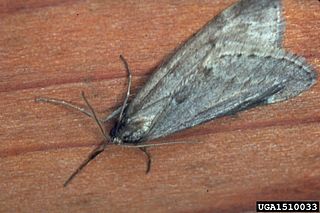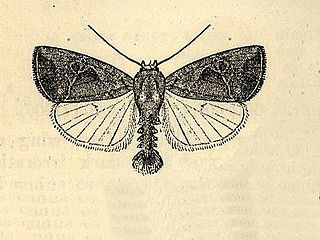
The luna moth, also called the American moon moth, is a Nearctic moth in the family Saturniidae, subfamily Saturniinae, a group commonly named the giant silk moths.

Helicoverpa zea, commonly known as the corn earworm, is a species in the family Noctuidae. The larva of the moth Helicoverpa zea is a major agricultural pest. Since it is polyphagous during the larval stage, the species has been given many different common names, including the cotton bollworm and the tomato fruitworm. It also consumes a wide variety of other crops.

The Pyralidae, commonly called pyralid moths, snout moths or grass moths, are a family of Lepidoptera in the ditrysian superfamily Pyraloidea. In many classifications, the grass moths (Crambidae) are included in the Pyralidae as a subfamily, making the combined group one of the largest families in the Lepidoptera. The latest review by Eugene G. Munroe and Maria Alma Solis retain the Crambidae as a full family of Pyraloidea.

Hyalophora cecropia, the cecropia moth, is North America's largest native moth. It is a member of the family Saturniidae, or giant silk moths. Females have been documented with a wingspan of five to seven inches or more. These moths can be found all across North America as far west as Washington and north into the majority of Canadian provinces. Cecropia moth larvae are most commonly found on maple trees, but they have also been found on cherry and birch trees among many others. The species was first described by Carl Linnaeus in his 1758 10th edition of Systema Naturae.

Tineola bisselliella, known as the common clothes moth, webbing clothes moth, or simply clothing moth, is a species of fungus moth. It is the type species of its genus Tineola and was first described by the Swedish entomologist Arvid David Hummel in 1823. It and a number of closely-related species are together known as the clothes moths due to their function as pests in human households. The specific name is commonly misspelled biselliella – for example by G. A. W. Herrich-Schäffer, when he established Tineola in 1853.

Lasioderma serricorne, more commonly referred to as the cigarette beetle, cigar beetle, or tobacco beetle, is a small beetle that shares a remarkable resemblance with the drugstore beetle and the common furniture beetle. The cigarette beetle, along with the drugstore and furniture beetles, all belong to the Ptinidae beetle family. The cigarette beetle can be distinguished from A. punctatum by its flatter thorax, whereas the A. punctatum boasts a humped thorax. The cigarette beetle can be further differentiated from S. paniceum with its uniformly serrated antennae composed of 11 segments, unlike the three-segmented antennae of S. paniceum. Additionally, L. serricorne has more shallow grooves in its elytra, or hardened wing covers, compared to the A. punctatum and S. paniceum’s deep grooving.

Agrotis ipsilon, the dark sword-grass, black cutworm, greasy cutworm, floodplain cutworm or ipsilon dart, is a small noctuid moth found worldwide. The moth gets its scientific name from black markings on its forewings shaped like the letter "Y" or the Greek letter upsilon. The larvae are known as "cutworms" because they cut plants and other crops. The larvae are serious agricultural pests and feed on nearly all varieties of vegetables and many important grains.

Araucaria hunsteinii is a species of Araucaria native to the mountains of Papua New Guinea. It is threatened by habitat loss.
Home-stored product entomology is the study of insects that infest foodstuffs stored in the home. It deals with the prevention, detection and eradication of pests.

The genus Crambus includes around 155 species of moths in the family Crambidae, distributed globally. The adult stages are called crambid snout moths, while the larvae of Crambus and the related genus Herpetogramma are the sod webworms, which can damage grasses.

Acrobasis vaccinii, the cranberry fruitworm, is a moth of the family Pyralidae described by Charles Valentine Riley in 1884. It is found in North America from Nova Scotia to Florida and from Wisconsin to Texas, it is introduced in the state of Washington.

Alsophila pometaria, the fall cankerworm, is a moth of the family Geometridae. It is found in North America from Nova Scotia west to Alberta, south to Colorado and California and zones of Spain

The South American potato tuber moth, Andean potato tuber moth or tomato stemborer is a moth of the family Gelechiidae. It is native to South America, but has become a pest worldwide. Records include North America, Australia and New Zealand.

Elaphria nucicolora, the sugarcane midget, is a moth of the family Noctuidae. The species was first described by Achille Guenée in 1852. It is found from the south-eastern United States, through Guadeloupe, Jamaica and Puerto Rico to tropical South America. It is also present on the Hawaiian islands of Oahu, Maui and Hawaii.

Simplicia cornicalis is a litter moth of the family Erebidae. The species was first described by Johan Christian Fabricius in 1794. It is found in south-eastern Asia and the Pacific. Records include New Caledonia, Réunion, Thailand, Fiji, Hawaii, India, Sri Lanka, the Society Islands, as well as New South Wales and Queensland in Australia. It is an introduced species in southern Florida and Louisiana in the United States.
Ithome concolorella, the kiawe flower moth, is a species of moth of the family Cosmopterigidae. It was first described by Vactor Tousey Chambers in 1875. It is found in the southern United States, including Texas, southern Arizona and Florida. It is an introduced species in Hawaii, where it has been recorded from Kauai, Oahu, Maui, Hawaii and Molokai.

Hellula undalis, the cabbage webworm or Old World webworm, is a moth of the family Crambidae. It is a widespread species which is found from Europe across Asia to the Pacific. It was first described from Italy.

Cadra figulilella, the raisin moth, is a moth of the family Pyralidae. The raisin moth is known most commonly as a pest that feeds on dried fruits, such as the raisin and date. It covers a range that includes much of the world, primarily situating itself in areas of California, Florida, the Eastern Mediterranean region, and some parts of Africa, Australia, and South America. The moth prefers to live in a hot, arid climate with little moisture and plentiful harvest for its larvae to feed on. Study of this species is important due to the vast amount of economic damage it causes yearly and worldwide to agriculture crops.

Bactra venosana, the nutgrass borer or nutsedge borer, is a moth of the family Tortricidae. It was first described by Philipp Christoph Zeller in 1847. Julius von Kennel provides a full description. It has a wide distribution, from southern Europe, North Africa and Asia Minor to India, Sri Lanka, southern China, Malaya, Australia and into the Pacific where it is found on Java, Borneo, the Philippines, Taiwan, Timor, the Solomons, the Carolines and Fiji. It was introduced to Hawaii in 1925 to control nutsedge. It is now found on Kauai, Oahu, Molokai, Maui, Lanai and Hawaii.

Pyrausta inornatalis, the inornate pyrausta moth, is a moth in the family Crambidae. It was described by Charles H. Fernald in 1885. It is found in United States, where it has been recorded from Arizona, California, Florida, Arkansas, Kansas, Louisiana, Missouri, Oklahoma, Tennessee and Texas. It is also found in Mexico. It has also been recorded as being in Alabama, Illinois, Oregon, Georgia, Kentucky, Mississippi, North Carolina, South Carolina, Virginia, and West Virginia.

















